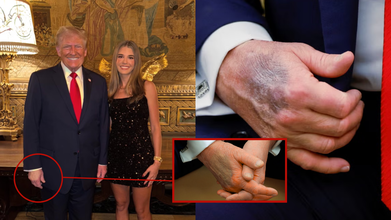- Health Conditions A-Z
- Health & Wellness
- Nutrition
- Fitness
- Health News
- Ayurveda
- Videos
- Medicine A-Z
- Parenting
- Web Stories
Antibiotics Are Not The Answer! NHS Doctor Explains Why Viral Infections Do Not Need Such Medication

Many people have become aware of medicines and what are certain medications used for, however this has led to some patients asking for specific medications from their doctors. They believe they understand better and often push doctors to give them what they think is right. Speaking about her experience with similar patients, Dr Mukherjee posted a video on Instagram calling out ‘pushy patients’
Dr. Bhasha Mukherjee, an NHS doctor, is strongly advising patients to listen to their doctors and rely on science when it comes to getting antibiotics. She wants everyone to understand that her main job is to make people better, not just to give them what they ask for, especially if it's not the right medical treatment.
"Pushy Patients" and Viral Infections
Dr. Mukherjee has been quite vocal about patients who insist on getting antibiotics for viral infections, like the common cold or the flu. She even shared her reasons in an Instagram post called "A pushy patient asks for antibiotics for a viral infection." In it, she clearly explained why she says no to these requests. The main reason is simple: antibiotics don't work against viruses. Using them too much can actually cause serious problems, including:
Antibiotic resistance: This makes future bacterial infections harder to treat.
Gut issues: Antibiotics can disrupt the natural balance of gut bacteria.
More harm than good: Unnecessary antibiotic use can lead to side effects without providing any benefit.
Dr. Mukherjee's message is clear, "I'm here to heal, not to please – and that means giving you the right treatment, not the requested one. Trust science. Trust your doctor."
When Are Antibiotics Appropriate?
The NHS confirms that antibiotics are specifically for bacterial infections. They are not effective against viruses. However, there are specific scenarios where antibiotics are necessary and beneficial
Non-serious but persistent bacterial infections
For ongoing issues such as severe acne, where the bacterial cause won't resolve naturally, antibiotics become necessary. They effectively target and eliminate the stubborn bacteria, leading to clearer skin and preventing long-term discomfort.
Contagious bacterial infections
Conditions like impetigo or chlamydia, which are easily transmissible to others, require antibiotics. This treatment not only heals the infected individual but also prevents the spread of the bacterial infection within the community, protecting public health.
To speed up recovery
In specific instances, such as a kidney infection, antibiotics play a crucial role. They quickly combat the bacterial invaders, significantly reducing symptoms and accelerating the patient's recovery, often preventing more severe illness.
Risk of serious complications
Anti biotics are very important for serious bacterial infections like pneumonia. These diseases can be life-threatening and using antibiotics weakens these bacteria, helping you reduce the risk of the disease escalating.
Antibiotic prophylaxis
In certain situations, antibiotics are administered as a proactive measure. This preventative approach helps to ward off potential infections before they even start, especially in vulnerable patients undergoing specific medical procedures or with weakened immune systems.
Exceptions for Vulnerable Patients
Even though antibiotics usually aren't prescribed for viral infections, doctors might consider them for people who are more likely to get very sick from such infections. This includes people over 75, newborn babies (under 72 hours old), individuals with heart failure, those who need insulin for diabetes, and anyone with a weakened immune system.
Why Avoid Unnecessary Antibiotic Use?
Besides not working on viruses, the NHS points out more reasons why doctors usually don't give antibiotics for viral infections. For one, they won't help you get better any more quickly. Also, taking antibiotics for small problems can make them stop working for more serious illnesses later which means the effectiveness of the medicine goes down. This is a big part of a worldwide issue called antibiotic resistance.
Kai Trump’s New Instagram Post Sparks Questions About Donald Trump’s Health And His Mysterious Hand Bruise

Credits: Instagram and Reuters
The US President Donald Trump's health has been a heated topic of debate ever since he has returned to the White House. The most speculated topic on his health comes from the dark bruise on his right hand. Now, a series of images, which is posted by his granddaughter has now revealed how long the President has had the discoloration on his hand.
These photos have now sparked a new set of questions on Trump's health, especially after Trump has be declared fit during his recent medical checkup.
Also Read: What Does Trump's Latest Health Checkup Reveal About Him?
What Did Kai Trump's Photo Reveal About Trump's Health?
His 18-year-old eldest granddaughter took to Instagram on Wednesday and posted a series of pictures to commemorate the anniversary of her YouTube journey. She wrote: "One year ago, I started my YouTube channel not knowing what to expect...and it is turned into something so special."
However, in one of the images, Kai is seen with Trump and the president had a thick layer of makeup on his hand that would cover the bruise. The image was taken on the day of the results at the watch party hosted by Trump at Mar-a-Lago. This proves that the President had this bruise that he covered with makeup much before he even took over the office.
This discovery made people believe that the White House is deliberately trying to hide the president's health issues for months, especially under the guise of his semi-annual health check that declared him fit.
When Was The First Time Trump's Bruise Was Noticed?
The bruise first came under public's eye soon after Trump was elected and he himself said in a TIME Magazine interview in December 2024, that this has happened due to frequently shaking hands with thousands of people.
Seconding the same, in 2025, the White House also used the same explanation, where his doctor Dr Sean Barbabella said that these bruises were "minor soft tissue irritation". The doctor also said that his has happened due to frequent handshaking by him and his use of aspirin as part of his normal heart health routine. The side effect of this, with his hand bruising like this was said to be a 'benign and well known" side effect.
In a memo published by White House, his physician noted: "consistent with minor soft tissue irritation from frequent handshaking and the use of aspirin, which is taken as part of a standard cardiovascular prevention regimen".
The medical report also noted that Trump's swollen ankles were caused by chronic venous insufficiency. This is a condition where veins find it difficult to send blood back to heart. The White House Press Secretary Karoline Leavitt told the media that Trump was still "in exceptional health", while backing the physician's comment on his health.
Recent Update On Trump's Health
Previously, Health And Me reported on an exclusive published on tabloid Radar, on October 16, that claimed that Trump is 'riddled with arthritis', and that he may need a double hip replacement surgery.
Read: Is US President Donald Trump Getting A Double Hip Replacement Surgery?
The tabloid’s report paints a sensational picture of severe arthritis and an alleged plan for double hip replacement, citing unnamed “sources” and hinting at possible cognitive issues. The story has since been picked up by several aggregator sites, spreading widely despite the absence of verified evidence. However, the publication provided no medical records, surgeon's statements, or official documents to support the claim.
However, as per the physical examination by the Walter Reed National Medical Center, President had no orthopedic surgery listed in his history.
Got Covid And Feeling Worse? These 3 Symptoms Could Be A Major Warning

Credits: Canva
Health officials are urging people to seek immediate medical help if they notice three particular symptoms appearing alongside Covid, as these could signal a more serious infection.
According to the latest data from the UK Health Security Agency (UKHSA), Covid cases have dipped slightly but remain present at “low levels” across the country. Hospital admissions have also fallen modestly, with weekly test positivity dropping to 10.3 percent from 11.9 percent the week before.
Despite the decline, people aged 85 and older continue to face the greatest risk of being hospitalised with the virus. Experts stress that identifying certain warning symptoms early can be key to preventing complications and ensuring timely treatment.
3 Covid Symptoms That Are Major Warning
People are being urged to seek urgent medical advice if they or their child develop three specific symptoms while infected with Covid, as it may point to a more serious illness.
Health experts recommend contacting a GP or calling for medical assistance if symptoms such as a rash, loss of appetite, or unusual weakness appear. Immediate help is also advised if a high temperature of 38°C or above lasts for five days or fails to reduce with paracetamol.
Medical attention is further encouraged if symptoms worsen, show no improvement, or if you are unsure how to manage them. For infants, extra caution is necessary as any baby under three months old with a temperature of 38°C or higher, or a child aged three to six months with a temperature above 39°C, should be assessed by a healthcare professional.
Covid Booster Shots: Who Can Get Them This Autumn
The eligibility rules for Covid booster vaccines have been updated for the current autumn rollout. While earlier boosters were offered to people aged 65 and above and those with certain long-term conditions, this year’s criteria have been made more specific.
Those eligible for the latest booster include:
- Adults aged 75 and over, including anyone who will turn 75 by January 31, 2026
- Individuals aged six months to 74 years with a weakened immune system due to illness or medical treatment
- Residents of care homes for older adults
- Health officials continue to encourage eligible groups to stay up to date with vaccinations, especially heading into the winter season, when respiratory infections tend to rise.
COVID-19 Variant Stratus: What You Should Know
A new COVID-19 strain known as Stratus, officially labeled XFG, has begun to circulate globally. First identified in Southeast Asia in January 2025, the variant quickly spread across 38 countries by mid-year. The World Health Organization (WHO) has classified Stratus as a “variant under monitoring,” meaning it is being closely studied to understand its transmission rate, symptom pattern, and potential health impact.
Frankenstein Variant: Common Symptoms of Stratus
For most people, especially those who are vaccinated or boosted, Stratus infections appear to be mild to moderate. Still, recognising its symptoms early remains important.
The most common signs include:
- Persistent dry cough
- Tiredness or fatigue
- Fever
- Other possible symptoms:
- Shortness of breath or chest tightness
- Sore or scratchy throat
- Headache and body aches
- Upset stomach, nausea, or loss of appetite
- Loss of taste or smell (now less frequent)
- Brain fog or difficulty concentrating
Atorvastatin Recall 2025: Safe Alternatives For Keeping Cholesterol In Check

Credits: CANVA
Atorvastatin Recall 2025: Statins have long been the first-line treatment for high cholesterol, but the Food and Drug Administration (FDA) has confirmed a nationwide recall of over 140,000 bottles of a cholesterol-lowering medication. Officials flagged that some pills may not dissolve properly after ingestion, potentially reducing effectiveness for patients who rely on them daily.
The recall affects Atorvastatin Calcium, the generic version of Lipitor, which is taken by roughly 39 million Americans, most of them adults over 40, according to Dr. Tamanna Singh of the Cleveland Clinic. Federal records show that the recalled batches were manufactured by Alkem Laboratories and distributed by Ascend Laboratories in New Jersey. The FDA’s September 19 enforcement report found that several batches failed quality tests designed to ensure proper dissolution of the pills.
If the pills dissolve inconsistently or more slowly than intended, the medication may not deliver the expected cholesterol-lowering effect. The FDA classified the recall as a Class II action, indicating moderate concern. While temporary or reversible side effects could occur, the likelihood of serious harm is low.
Atorvastatin Recall: Which Atorvastatin Tablets Are Affected
The recall covers multiple strengths and bottle sizes of Atorvastatin Calcium Tablets, which are among the most commonly prescribed statins globally. Affected formulations include:
- 10 mg – 90, 500, and 1,000 tablets per bottle
- 20 mg – 90, 500, and 1,000 tablets per bottle
- 40 mg – 90, 500, and 1,000 tablets per bottle
- 80 mg – 90 and 500 tablets per bottle
Cholesterol Medication Recalled: Safe Alternatives to Atorvastatin
If you are affected by the recall, there are several alternatives to help manage cholesterol levels effectively:
1. Ezetimibe (Zetia)
Ezetimibe is often recommended when a statin alone doesn’t sufficiently lower cholesterol. It may be used if you are on the maximum statin dose but your cholesterol remains high, or alongside statins such as atorvastatin or simvastatin for conditions like homozygous familial hypercholesterolemia.
Ezetimibe works by blocking cholesterol absorption in the small intestine, causing the body to use up more cholesterol from the blood. It is one of the few non-statin medications that can further reduce LDL cholesterol, either alone or combined with statins or other alternatives.
2. Fibrates (e.g., gemfibrozil, fenofibrate)
Fibrates mainly target high triglyceride levels, a type of fat in the blood linked to heart disease and pancreatitis, and can also mildly lower LDL cholesterol. They can be taken alone, with ezetimibe, or with a statin. However, combining gemfibrozil with a statin may increase side effects, so caution is advised.
3. Bile Acid Sequestrants (e.g., cholestyramine, colestipol, colesevelam)
Bile acid sequestrants lower cholesterol by binding bile acids in the intestine, preventing their reabsorption. The liver then uses more cholesterol from the blood to produce new bile acids, reducing LDL cholesterol.
Potential drawbacks include:
- Multiple pills per day may be needed
- Possible interactions with other medications or vitamins, which can reduce effectiveness
- May increase triglyceride levels
- Can cause constipation or stomach upset
Disclaimer: The information provided is for general awareness only and should not be considered medical advice. Always consult a qualified healthcare professional before starting, stopping, or changing any medication or treatment.
© 2024 Bennett, Coleman & Company Limited

